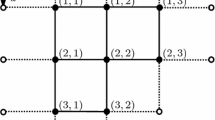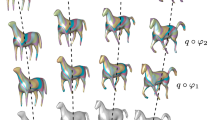Abstract
Level Set methods use a non-parametric, implicit representation of surfaces such as the signed distance function. These methods are applied to multiview 3D reconstruction and other machine vision problems that need correspondences between views of a surface. Correspondences can be found by matching surface texture patches of the size sufficient for their identification. Good matching requires precise mapping of a patch across the two image planes. Affine mapping is often used for this purpose assuming that the patches are small and nearly flat. However, this assumption is violated in locations of high surface curvature and/or when the surface is poorly textured and large windows are needed to provide enough information. Using second-order surface approximation, we derive a more precise, quadratic transformation for planar mapping of implicit surfaces. To validate this theoretical result, we apply it to correlation based, variational multiview 3D reconstruction using Level Sets. It is shown that a more detailed reconstruction can be achieved compared to the traditional affine mapping.





Similar content being viewed by others
Notes
The scalar triple product of three vectors is defined as [a,b,c]=a⋅(b×c)=b⋅(c×a)=c⋅(a×b).
Here, we approximate the inverse Hessians by \((\mathbf {J}_{}^{-1})^{T} \mathbf{H} \mathbf {J}_{}^{-1}\), which is sufficient for our purposes.
References
Abraham, R., Marsden, J.E., Ratiu, T.S.: Manifolds, tensor analysis, and applications. Springer, Berlin (1988)
Caselles, V., Kimmel, R., Sapiro, G., Sbert, C.: Minimal surfaces based object segmentation. IEEE Trans. Pattern Anal. Mach. Intell. 19, 394–398 (1997)
Faugeras, O., Keriven, R.: Variational principles, surface evolution, PDE-s, level set methods, and the stereo problem. Technical Report 3021, INRIA (1996)
Faugeras, O., Keriven, R.: Variational principles, surface evolution, PDE-s, level set methods, and the stereo problem. IEEE Trans. Image Process. 7, 336–344 (1998)
Goldenberg, R., Kimmel, R., Rivlin, E., Rudzsky, M.: Fast geodesic active contours. IEEE Trans. Image Process. 10, 1467–1475 (2001)
Hartley, R., Zisserman, A.: Multiple View Geometry in Computer Vision. Cambridge University Press, Cambridge (2003)
Ihrke, I., Kutulakos, K.N., Magnor, M., Heidrich, W.: In: EUROGRAPHICS 2008 STAR—State of the Art Report: State of the Art in Transparent and Specular Object Reconstruction (2008)
Jin, H., Soatto, S., Yezzi, A.: Multi-view stereo beyond Lambert. In: Conf. on Computer Vision and Pattern Recognition, vol. 1 (2003)
Mikolajczyk, K., et al.: A comparison of affine region detectors. Int. J. Comput. Vis. 65, 43–72 (2005)
Kimmel, R.: 3D shape reconstruction from autostereograms and stereo. J. Vis. Commun. Image Represent. 13, 324–333 (2002)
Li, G., Zucker, S.: Differential geometric consistency extends stereo to curved surfaces. In: Proc. European Conf. on Computer Vision, pp. 44–57. Springer, Berlin (2006)
Megyesi, Z., Chetverikov, D.: Affine propagation for surface reconstruction in wide baseline stereo. In: Proc. International Conf. on Pattern Recognition, vol. 4, pp. 76–79 (2004)
Seitz, S.M., Curless, B., Diebel, J., Scharstein, D., Szeliski, R.: A comparison and evaluation of multi-view stereo reconstruction algorithms. In: Conf. on Computer Vision and Pattern Recognition, vol. 1, pp. 519–528 (2006)
Sethian, J.A.: Level Set Methods and Fast Marching Methods. Cambridge University Press, Cambridge (2002)
Strecha, C., Tuytelaars, T., Van Gool, L.: Dense matching of multiple wide baseline views. In: Proc. International Conf. on Computer Vision, vol. 2, pp. 1194–1201 (2003)
Woodford, O., Torr, P., Reid, I., Fitzgibbon, A.: Global stereo reconstruction under second-order smoothness priors. In: IEEE Trans. Pattern Analysis and Machine Intelligence, pp. 2115–2128 (2009)
Acknowledgements
This research was supported in part by the NKTH-OTKA grant CK 78409. The authors are grateful to János Urbán and Csaba Kazó for their help in implementing and testing the multiview reconstruction methods.
Author information
Authors and Affiliations
Corresponding author
Appendix: Derivation of Equations (17) and (18)
Appendix: Derivation of Equations (17) and (18)
Below, we briefly explain how equations (17) and (18) are derived. The explanations are not comprehensive as the main steps are only given, especially in the case of (18) whose derivation is quite involved. We consider the higher order terms of (11) that contain \(\mathbf {J}_{i}^{-T} \mathbf {H}_{\alpha k} \mathbf {J}_{i}^{-1}\), α∈{x,y},k∈{i,j}. Calculating the partial derivatives in J i and H αk , we have
and
where
Substituting (25) and (26) into \(\mathbf {J}_{i}^{-T} \mathbf {H}_{\alpha k} \mathbf {J}_{i}^{-1}\), after some straightforward re-arrangements we obtain equations (13)–(16) with

and

We seek a non-parametric form for the above quantities. After re-grouping, the first expression simplifies as

which leads to (17).
Equation (18) is more difficult to obtain. First, we will show that |N|2 T αk can be represented as

where II is the second fundamental form. Then we will prove that this expression is equivalent to

We start by introducing
where S u ,S v is the covariant, S u,S v the contravariant basis, and
Substituting this into (30), we obtain

where

and m,n∈{u,v}. Considering a coordinate transform u′=u′(u,v), v′=v′(u,v) and applying the chain rule to the derivatives, it is easy to show that n⋅S mn are coordinates of a second-rank covariant tensor for every m,n∈{u,v}. Next, we observe that S p ⋅S mn can be expressed using the Christoffel symbols \(\mathbf {\varGamma }^{q}_{mn}\):
where p,q∈{u,v}. For example,
It is known from tensor analysis [1] that a coordinate transformation exists in every point of a parametric surface that sets all Christoffel symbols to zero (geodesic coordinates). Applying such transformation, in (31) we can eliminate B mn and C mn , and this expression reduces to

where the first row is the original expression given in (30). (We do not introduce new notation for the transformed coordinates.) Applying to both sides the scalar product by −[N]× and using (27), we obtain the representation (28). This representation is useful, but it contains the parametric second fundamental form. Now we will prove that the representation (29) is equivalent to (28). Consider the components of (29):



Multiplying (33) by \(( \mbox{\boldmath$\nabla $}\alpha _{k}\cdot \mathbf {n})\), we obtain an expression identical to (28).
Rights and permissions
About this article
Cite this article
Molnár, J., Chetverikov, D. Quadratic Transformation for Planar Mapping of Implicit Surfaces. J Math Imaging Vis 48, 176–184 (2014). https://doi.org/10.1007/s10851-012-0407-2
Published:
Issue Date:
DOI: https://doi.org/10.1007/s10851-012-0407-2




